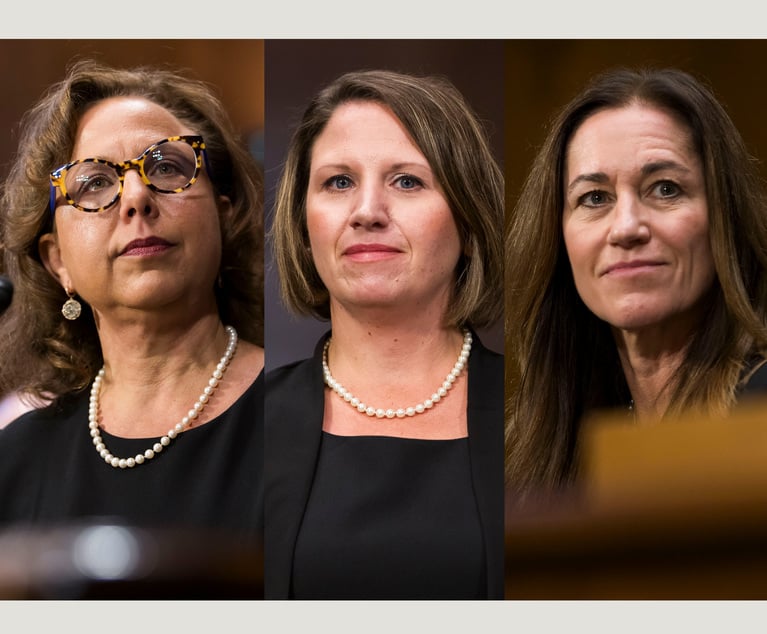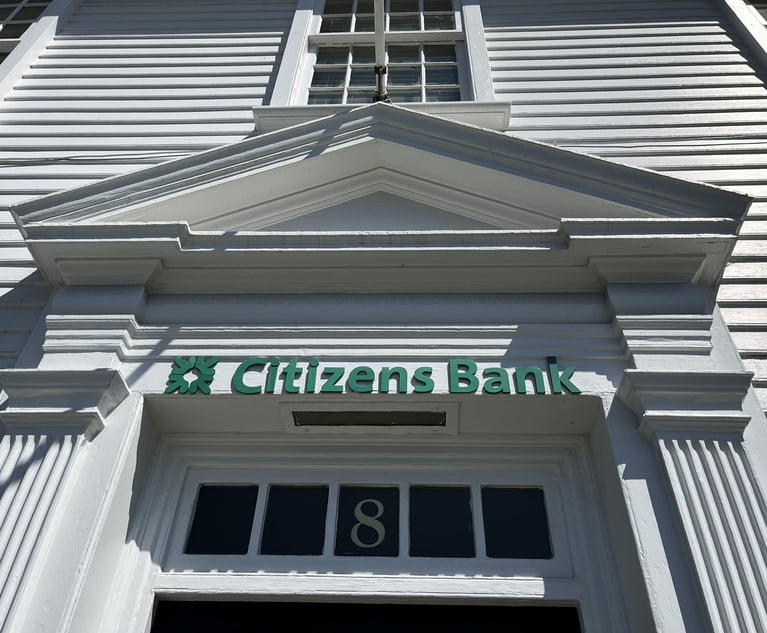Avoiding Loss of Patent Rights in the Post-America Invents Act Era
Many observers greeted the Sept. 16, 2011, passage of the Leahy-Smith America Invents Act (AIA) into law as a long-overdue overhaul of U.S. patent law that aligned it with patent systems prevailing in the rest of the world. Who knew what mischief just seven of the AIA's more than 25,000 words contained?
July 30, 2019 at 12:26 PM
10 minute read
 Glenn Murphy of RatnerPrestia.
Glenn Murphy of RatnerPrestia.The law of unintended consequences pushes us ceaselessly through the years, permitting no pause for perspective. —Richard Schickel
Lawmakers who interfere with commerce and the normal creation of jobs in an economy run the risk of doing harm rather than good. Unintended consequences from regulating or legislating to achieve a goal can occur and cause havoc in the markets or an economy. —Mark Skousen
Many observers greeted the Sept. 16, 2011, passage of the Leahy-Smith America Invents Act (AIA) into law as a long-overdue overhaul of U.S. patent law that aligned it with patent systems prevailing in the rest of the world. Who knew what mischief just seven of the AIA's more than 25,000 words contained? The U.S. Supreme Court answered earlier this year in Helsinn Healthcare v. Teva Pharmaceuticals USA, 586 U.S. ___ (Jan. 22, 2019).
The words in question are the phrase “or otherwise available to the public” and the word “disclosure.” These words or words like them have been used in the patent lexicon long before the AIA. But Congress' injection of these words into the patent statute's definitions of novelty and prior art appears to have missed its mark. More concerning, it may have created unintended risks for innovating persons and entities, particularly individuals and smaller and start-up entities, whose business models necessarily involve engaging in early-stage commercial partnerships in pursuit of a larger goal or enterprise.
Both before and after the AIA, Section 102 of the U.S. Code defined the conditions under which an invention is determined to be novel, i.e., that it is new, as well as events that would bar an applicant from obtaining a patent, the so-called “statutory bars.” Before the AIA revisions, Section 102 provided: “A person shall be entitled to a patent unless—the invention was patented or described in a printed publication in this or a foreign country or in public use or on sale in this country, more than one year prior to the date of the application for patent in the United States … .”
Under the pre-AIA version of Section 102, an inventor's commercial sale or offer to sell an invention, whether public or confidential, would start the clock running on the one-year “grace period” to file a patent application. The statutory bar provisions balanced the competing interests of encouraging inventors to disclose their inventions promptly for the public's benefit (through the filing of a patent application), providing inventors a reasonable time to develop and perfect their invention before applying for a patent, and preventing inventors from commercially exploiting their inventions for more than one year before seeking a patent.
The AIA amendments to Section 102, effective March 16, 2013, relocated the statutory bar provisions to new 35 U.S.C. Section 102(a)(1) and carried forward the concept of a “grace period” in new 35 U.S.C. Section 102(b): Novelty; prior art—A person shall be entitled to a patent unless—the claimed invention was patented, described in a printed publication, or in public use, on sale, or otherwise available to the public before the effective filing date of the claimed invention; Exceptions—Disclosures made one year or less before the effective filing date of the claimed invention—A disclosure made one year or less before the effective filing date of a claimed invention shall not be prior art to the claimed invention under subsection (a)(1) if:
- The disclosure was made by the inventor or joint inventor or by another who obtained the subject matter disclosed directly or indirectly from the inventor or a joint inventor; or
- The subject matter disclosed had, before such disclosure, been publicly disclosed by the inventor or a joint inventor or another who obtained the subject matter disclosed directly or indirectly from the inventor or a joint inventor.
The AIA version of the statutory bar lists the same patent-barring events as in the pre-AIA version of the statute—patented, described in a printed publication, public use, on sale—but adds to this list the phrase “or otherwise available to the public.”
The legislative history of the AIA contains some evidence that by adding “or otherwise available to the public,” Congress had intended to exclude confidential sales or offers to sell an invention from triggering the on-sale bar. Sen. Patrick Leahy testified that “Section 102(a) was drafted in part to do away with precedent under current law that private offers for sale or private uses or secret processes practiced in the United States that result in a product or service that is then made public may be deemed patent-defeating prior art.” Other evidence supports the senator's testimony. See remarks of Sen. John Kyl at 157 Cong. Rec. 3424 (2011).
Congress' intent behind the reformation of the grace period in Section 102(b) is less clear. Congress did not explicitly define what it meant by “disclosures” in the new Section 102(b), nor did it explain the relationship of “disclosures” to the patent-barring events in new Section 102(a)(1). But “disclosure” is not a new word to the patent lexicon, and one rather significant use of it is to refer to a description of an invention that would enable a person of skill in the art to which the invention pertains (i.e., the public) to make and use the invention. One might reasonably infer that Congress' use of “disclosures” in Section 102(b) refers to the events in Section 102(a), that “otherwise” make the invention “available to the public.” Enter Helsinn.
Helsinn Healthcare, a Swiss pharmaceutical company, held rights to make and develop the drug palonosetron to treat chemotherapy-induced nausea. In April 2000 Helsinn entered into agreements in which Helsinn would exclusively supply MGI Pharma, Inc. (MGI), and MGI would exclusively distribute, promote, market and sell, 0.25 mg doses of palonosetron in the United States. The agreements were published in a joint press release and filed in MGI's Form 8–K filings with the SEC. Both agreements included dosage information, but required MGI to keep that information confidential, and the specific dosage formulations were redacted from the publicly available copies of the agreements. Nearly two years after Helsinn and MGI entered into the agreements, Helsinn filed a provisional patent application, leading eventually to Helsinn's fourth patent, covering an 0.25 mg dose form, filed in May 2013, and being governed by the AIA.
Helsinn sued Teva Pharmaceuticals USA (Teva) in 2011 alleging infringement of the fourth patent. Teva argued that the April 2000 agreements with MGI constituted sales of the invention more that barred Helsinn's patent. The district court disagreed, finding that Congress changed the meaning of “on sale” in the new AIA Section 102(a)(1) by adding “or otherwise available to the public.” The new language required a public sale or offer of sale, and that to be public, a sale or offer must disclose the details of the invention. Because they did not disclose the dosage form claimed in the patent, the 2000 Helsinn-MGI agreements did not raise the on-sale bar. See Helsinn Healthcare v. Teva Pharmaceuticals USA, 855 F.3d 1356 at 1363 (Fed. Cir. 2017).
The federal circuit and the Supreme Court disagreed with this conclusion, both rejecting the district court's reliance on the legislative record to interpret the new statute. “Our prior cases have applied the on-sale bar even when … members of the public could not ascertain the claimed invention. There is no indication in the floor statements that these members intended to overrule these cases.” “The addition of 'or otherwise available to the public' is simply not enough of a change for us to conclude that Congress intended to alter the meaning of the reenacted term 'on sale.' … Because we determine that Congress did not alter the meaning of “on sale” when it enacted the AIA, we hold that an inventor's sale of an invention to a third party who is obligated to keep the invention confidential can qualify as prior art under Section 102(a).”
So much for the intended consequences. Despite Congress' apparent attempt to exclude from the statutory bar any prior commercial activity by the inventor that does not place the details of an invention into the public domain, both the federal circuit and the Supreme Court felt that in enacting the AIA, Congress had not made that intent sufficiently clear to afford it legal recognition. Thus under Section 102(a)(1), as interpreted by the Supreme Court in Helsinn, a publicly disclosed commercial sale of an invention by the inventor that does not place the details of the invention into the public domain, if more than one year before the effective filing date of a patent, can qualify as invalidating prior art under AIA Section 102(a)(1).
A related and just as significant question not addressed by the Helsinn decision is whether any prior commercial sale or offer to sell an invention that does not put the details of the invention into the public domain would benefit from the exclusion under AIA Section 102(b). Of course the Helsinn courts had no reason to consider that issue because the sale in that case was clearly more than one year before the critical date of the patent. Would the events is Helsinn that triggered the on-sale bar under Section 102(a)(1) benefit from the grace period under Section 102(b) if they took place less than a year before the critical date of the patent?
Both the federal circuit and the Supreme Court emphasized the policy that the patent statute should encourage prompt disclosure of inventions to the public. One cannot reasonably exclude the possibility that a future decision will hold that sales activities like Helsinn's trigger the bar but are not entitled to a grace period under the new statute because they do not disclose the invention to the public. Until this issue is resolved, inventors would be wise to assume that any confidential sales activity prior to applying for a patent might not be accorded a grace period and to file patent applications before consummating any such transactions accordingly. And for those innovating individuals and entities who in the wake of the AIA's passage ordered their affairs in reliance on the stated intent of Congress in enacting the changes to Section 102, and who sought to insulate their early commercial activity from invoking the on-sale bar by conducting it under obligations of confidence, only time and more litigation will reveal further the unintended consequences of Congress' latest attempts at patent reform.
Glenn E.J. Murphy, counsel at RatnerPrestia, focuses his practice on building and managing domestic and international utility and design patent portfolios and opining on the validity and infringement of U.S. patents. Murphy has briefed and argued before the U.S. Patent Office Board of Appeals, assisted with the preparation and argument of appeals before the U.S. Court of Appeals for the Federal Circuit, and assisted with the conduct of bench and jury trials in the U.S. district courts and the U.S. International Trade Commission.
This content has been archived. It is available through our partners, LexisNexis® and Bloomberg Law.
To view this content, please continue to their sites.
Not a Lexis Subscriber?
Subscribe Now
Not a Bloomberg Law Subscriber?
Subscribe Now
NOT FOR REPRINT
© 2025 ALM Global, LLC, All Rights Reserved. Request academic re-use from www.copyright.com. All other uses, submit a request to [email protected]. For more information visit Asset & Logo Licensing.
You Might Like
View All
Pa. Federal District Courts Reach Full Complement Following Latest Confirmation

The Defense Bar Is Feeling the Strain: Busy Med Mal Trial Schedules Might Be Phila.'s 'New Normal'
7 minute read
Federal Judge Allows Elderly Woman's Consumer Protection Suit to Proceed Against Citizens Bank
5 minute read
Judge Leaves Statute of Limitations Question in Injury Crash Suit for a Jury
4 minute readTrending Stories
Who Got The Work
J. Brugh Lower of Gibbons has entered an appearance for industrial equipment supplier Devco Corporation in a pending trademark infringement lawsuit. The suit, accusing the defendant of selling knock-off Graco products, was filed Dec. 18 in New Jersey District Court by Rivkin Radler on behalf of Graco Inc. and Graco Minnesota. The case, assigned to U.S. District Judge Zahid N. Quraishi, is 3:24-cv-11294, Graco Inc. et al v. Devco Corporation.
Who Got The Work
Rebecca Maller-Stein and Kent A. Yalowitz of Arnold & Porter Kaye Scholer have entered their appearances for Hanaco Venture Capital and its executives, Lior Prosor and David Frankel, in a pending securities lawsuit. The action, filed on Dec. 24 in New York Southern District Court by Zell, Aron & Co. on behalf of Goldeneye Advisors, accuses the defendants of negligently and fraudulently managing the plaintiff's $1 million investment. The case, assigned to U.S. District Judge Vernon S. Broderick, is 1:24-cv-09918, Goldeneye Advisors, LLC v. Hanaco Venture Capital, Ltd. et al.
Who Got The Work
Attorneys from A&O Shearman has stepped in as defense counsel for Toronto-Dominion Bank and other defendants in a pending securities class action. The suit, filed Dec. 11 in New York Southern District Court by Bleichmar Fonti & Auld, accuses the defendants of concealing the bank's 'pervasive' deficiencies in regards to its compliance with the Bank Secrecy Act and the quality of its anti-money laundering controls. The case, assigned to U.S. District Judge Arun Subramanian, is 1:24-cv-09445, Gonzalez v. The Toronto-Dominion Bank et al.
Who Got The Work
Crown Castle International, a Pennsylvania company providing shared communications infrastructure, has turned to Luke D. Wolf of Gordon Rees Scully Mansukhani to fend off a pending breach-of-contract lawsuit. The court action, filed Nov. 25 in Michigan Eastern District Court by Hooper Hathaway PC on behalf of The Town Residences LLC, accuses Crown Castle of failing to transfer approximately $30,000 in utility payments from T-Mobile in breach of a roof-top lease and assignment agreement. The case, assigned to U.S. District Judge Susan K. Declercq, is 2:24-cv-13131, The Town Residences LLC v. T-Mobile US, Inc. et al.
Who Got The Work
Wilfred P. Coronato and Daniel M. Schwartz of McCarter & English have stepped in as defense counsel to Electrolux Home Products Inc. in a pending product liability lawsuit. The court action, filed Nov. 26 in New York Eastern District Court by Poulos Lopiccolo PC and Nagel Rice LLP on behalf of David Stern, alleges that the defendant's refrigerators’ drawers and shelving repeatedly break and fall apart within months after purchase. The case, assigned to U.S. District Judge Joan M. Azrack, is 2:24-cv-08204, Stern v. Electrolux Home Products, Inc.
Featured Firms
Law Offices of Gary Martin Hays & Associates, P.C.
(470) 294-1674
Law Offices of Mark E. Salomone
(857) 444-6468
Smith & Hassler
(713) 739-1250





